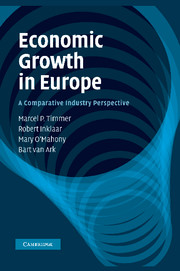Book contents
- Frontmatter
- Contents
- List of figures
- List of tables
- Preface and acknowledgements
- 1 Introduction and overview
- 2 Economic growth in Europe
- 3 EU KLEMS database
- 4 Structural change
- 5 The industry origins of aggregate growth
- 6 Productivity levels and convergence
- 7 Drivers of productivity growth in Europe
- References
- Index
6 - Productivity levels and convergence
Published online by Cambridge University Press: 06 December 2010
- Frontmatter
- Contents
- List of figures
- List of tables
- Preface and acknowledgements
- 1 Introduction and overview
- 2 Economic growth in Europe
- 3 EU KLEMS database
- 4 Structural change
- 5 The industry origins of aggregate growth
- 6 Productivity levels and convergence
- 7 Drivers of productivity growth in Europe
- References
- Index
Summary
Introduction
When analysing cross-country patterns, growth accounts provide only a partial analysis. It is now widely accepted that understanding the pattern of cross-country growth and productivity requires estimates of relative levels. Models in the technology-gap tradition consider technological effort as the main determinant of income differences between countries and international technology diffusion as the driving force for catch-up. The rate of catch-up of one country with another depends upon the two forces of innovation and imitation. Innovation refers to the creation of new technologies unknown to the world and imitation refers to the spillover of existing technologies from leading to following countries. The larger the distance from the world technology frontier, the higher the rate of diffusion to a follower might be. But the cost of imitation rises as the pool of non-copied ideas becomes smaller and the potential for growth decreases. The effectiveness of educational systems, technology policies and market regulation might thus crucially depend on the distance to the technology frontier (Fagerberg 1994). In the same vein, Aghion and Howitt (2006) suggest that the post-World War II catch-up of European economies to the USA has slowed down as the technology gap with the USA has narrowed. Policies and institutions which facilitated imitation of technologies in the past are not well suited for growth close to the technology frontier. The latter should be based on innovation in a competitive market environment and rooted in a country's own resources such as skilled labour and research and development.
- Type
- Chapter
- Information
- Economic Growth in EuropeA Comparative Industry Perspective, pp. 189 - 251Publisher: Cambridge University PressPrint publication year: 2010



